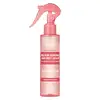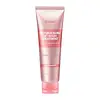What's inside
What's inside
 Key Ingredients
Key Ingredients

 Benefits
Benefits

 Concerns
Concerns

 Ingredients Side-by-side
Ingredients Side-by-side

Water
Skin ConditioningAlcohol Denat.
AntimicrobialCetyl Ethylhexanoate
EmollientC12-15 Alkyl Benzoate
AntimicrobialCaprylic/Capric Triglyceride
MaskingDisiloxane
Skin ConditioningDicaprylyl Carbonate
EmollientPanthenol
Skin ConditioningSodium Chloride
MaskingDisodium EDTA
Ethylhexylglycerin
Skin ConditioningRosa Damascena Flower Water
MaskingAloe Barbadensis Leaf Extract
EmollientCoco-Caprylate/Caprate
EmollientArgania Spinosa Kernel Oil
EmollientCocos Nucifera Oil
MaskingSimmondsia Chinensis Seed Oil
EmollientTulipa Gesneriana Flower Extract
Skin ConditioningHibiscus Sabdariffa Flower Extract
Skin ConditioningChlorella Ferment
Skin Conditioning1,2-Hexanediol
Skin ConditioningMaltodextrin
AbsorbentHydrolyzed Vegetable Protein
Skin ConditioningPropanediol
SolventGlycerin
HumectantHydrogenated Lecithin
EmulsifyingCeramide NP
Skin ConditioningCholesterol
EmollientPisum Sativum Peptide
Skin ConditioningParfum
MaskingWater, Alcohol Denat., Cetyl Ethylhexanoate, C12-15 Alkyl Benzoate, Caprylic/Capric Triglyceride, Disiloxane, Dicaprylyl Carbonate, Panthenol, Sodium Chloride, Disodium EDTA, Ethylhexylglycerin, Rosa Damascena Flower Water, Aloe Barbadensis Leaf Extract, Coco-Caprylate/Caprate, Argania Spinosa Kernel Oil, Cocos Nucifera Oil, Simmondsia Chinensis Seed Oil, Tulipa Gesneriana Flower Extract, Hibiscus Sabdariffa Flower Extract, Chlorella Ferment, 1,2-Hexanediol, Maltodextrin, Hydrolyzed Vegetable Protein, Propanediol, Glycerin, Hydrogenated Lecithin, Ceramide NP, Cholesterol, Pisum Sativum Peptide, Parfum
Cyclopentasiloxane
EmollientWater
Skin ConditioningButylene Glycol
HumectantDimethiconol
EmollientCetyl Alcohol
EmollientGlycerin
HumectantBehentrimonium Chloride
PreservativeStearyl Alcohol
EmollientCetrimonium Chloride
AntimicrobialIsopropyl Alcohol
SolventMyristyl Alcohol
EmollientRosa Centifolia Flower Extract
AstringentCaprylyl Glycol
EmollientLauryl Alcohol
Emollient1,2-Hexanediol
Skin ConditioningMaltodextrin
AbsorbentHibiscus Sabdariffa Flower Extract
Skin ConditioningTulipa Gesneriana Flower Extract
Skin ConditioningChlorella Ferment
Skin ConditioningPrunus Amygdalus Dulcis Oil
Skin ConditioningPistacia Vera Seed Oil
Skin ConditioningGardenia Taitensis Flower Extract
Skin ConditioningAleurites Moluccanus Seed Oil
Skin ConditioningMacadamia Ternifolia Seed Oil
EmollientSclerocarya Birrea Seed Oil
HumectantPropanediol
SolventPolysorbate 20
EmulsifyingCitric Acid
BufferingSodium Citrate
BufferingHydrolyzed Soy Protein
HumectantHydrolyzed Corn Protein
Skin ConditioningHydrolyzed Wheat Protein
Skin ConditioningGlycine
BufferingSerine
MaskingGlutamic Acid
HumectantBenzyl Glycol
SolventAspartic Acid
MaskingLeucine
Skin ConditioningHydrolyzed Glycosaminoglycans
HumectantSodium Hyaluronate
HumectantAlanine
MaskingLysine
Skin ConditioningArginine
MaskingTyrosine
MaskingPhenylalanine
MaskingProline
Skin ConditioningThreonine
Valine
MaskingIsoleucine
Skin ConditioningEthylhexylglycerin
Skin ConditioningHistidine
HumectantCysteine
AntioxidantMethionine
Skin ConditioningSodium Hyaluronate Crosspolymer
HumectantHydrolyzed Hyaluronic Acid
HumectantHydroxypropyltrimonium Hyaluronate
Hyaluronic Acid
HumectantSodium Acetylated Hyaluronate
HumectantDisodium EDTA
Hydroxyacetophenone
AntioxidantChlorphenesin
AntimicrobialParfum
MaskingCyclopentasiloxane, Water, Butylene Glycol, Dimethiconol, Cetyl Alcohol, Glycerin, Behentrimonium Chloride, Stearyl Alcohol, Cetrimonium Chloride, Isopropyl Alcohol, Myristyl Alcohol, Rosa Centifolia Flower Extract, Caprylyl Glycol, Lauryl Alcohol, 1,2-Hexanediol, Maltodextrin, Hibiscus Sabdariffa Flower Extract, Tulipa Gesneriana Flower Extract, Chlorella Ferment, Prunus Amygdalus Dulcis Oil, Pistacia Vera Seed Oil, Gardenia Taitensis Flower Extract, Aleurites Moluccanus Seed Oil, Macadamia Ternifolia Seed Oil, Sclerocarya Birrea Seed Oil, Propanediol, Polysorbate 20, Citric Acid, Sodium Citrate, Hydrolyzed Soy Protein, Hydrolyzed Corn Protein, Hydrolyzed Wheat Protein, Glycine, Serine, Glutamic Acid, Benzyl Glycol, Aspartic Acid, Leucine, Hydrolyzed Glycosaminoglycans, Sodium Hyaluronate, Alanine, Lysine, Arginine, Tyrosine, Phenylalanine, Proline, Threonine, Valine, Isoleucine, Ethylhexylglycerin, Histidine, Cysteine, Methionine, Sodium Hyaluronate Crosspolymer, Hydrolyzed Hyaluronic Acid, Hydroxypropyltrimonium Hyaluronate, Hyaluronic Acid, Sodium Acetylated Hyaluronate, Disodium EDTA, Hydroxyacetophenone, Chlorphenesin, Parfum
 Reviews
Reviews

Ingredients Explained
These ingredients are found in both products.
Ingredients higher up in an ingredient list are typically present in a larger amount.
1,2-Hexanediol is a synthetic liquid and another multi-functional powerhouse.
It is a:
- Humectant, drawing moisture into the skin
- Emollient, helping to soften skin
- Solvent, dispersing and stabilizing formulas
- Preservative booster, enhancing the antimicrobial activity of other preservatives
Chlorella Ferment isn't fungal acne safe.
Disodium EDTA plays a role in making products more stable by aiding other preservatives.
It is a chelating agent, meaning it neutralizes metal ions that may be found in a product.
Disodium EDTA is a salt of edetic acid and is found to be safe in cosmetic ingredients.
Learn more about Disodium EDTAEthylhexylglycerin (we can't pronounce this either) is commonly used as a preservative and skin softener. It is derived from glyceryl.
You might see Ethylhexylglycerin often paired with other preservatives such as phenoxyethanol. Ethylhexylglycerin has been found to increase the effectiveness of these other preservatives.
Glycerin is already naturally found in your skin. It helps moisturize and protect your skin.
A study from 2016 found glycerin to be more effective as a humectant than AHAs and hyaluronic acid.
As a humectant, it helps the skin stay hydrated by pulling moisture to your skin. The low molecular weight of glycerin allows it to pull moisture into the deeper layers of your skin.
Hydrated skin improves your skin barrier; Your skin barrier helps protect against irritants and bacteria.
Glycerin has also been found to have antimicrobial and antiviral properties. Due to these properties, glycerin is often used in wound and burn treatments.
In cosmetics, glycerin is usually derived from plants such as soybean or palm. However, it can also be sourced from animals, such as tallow or animal fat.
This ingredient is organic, colorless, odorless, and non-toxic.
Glycerin is the name for this ingredient in American English. British English uses Glycerol/Glycerine.
Learn more about GlycerinThis extract comes from the Roselle flower, or Hibiscus Sabdariffa. Roselle flowers are rich in antioxidants.
Studies found the antioxidants in Roselle flowers to potentially help reduce UV-B damage.
Maltodextrin is a polysaccharide. It is derived from starch such as rice, corn, wheat, or potato starch.
In food, Maltodextrin is used to improve the texture and thicken a product. Due to its structure, it can help create a gel texture. As an emulsion stabilizer, it helps keep the ingredients in a product together.
As a polysaccharide, Maltodextrin has moisturizing properties. Polysaccharides are a type of carbohydrate. The top layer of skin uses polysaccharides to retain water, keeping the skin hydrated.
Maltodextrin is water soluble and has a sweet taste.
Learn more about MaltodextrinParfum is a catch-all term for an ingredient or more that is used to give a scent to products.
Also called "fragrance", this ingredient can be a blend of hundreds of chemicals or plant oils. This means every product with "fragrance" or "parfum" in the ingredients list is a different mixture.
For instance, Habanolide is a proprietary trade name for a specific aroma chemical. When used as a fragrance ingredient in cosmetics, most aroma chemicals fall under the broad labeling category of “FRAGRANCE” or “PARFUM” according to EU and US regulations.
The term 'parfum' or 'fragrance' is not regulated in many countries. In many cases, it is up to the brand to define this term.
For instance, many brands choose to label themselves as "fragrance-free" because they are not using synthetic fragrances. However, their products may still contain ingredients such as essential oils that are considered a fragrance by INCI standards.
One example is Calendula flower extract. Calendula is an essential oil that still imparts a scent or 'fragrance'.
Depending on the blend, the ingredients in the mixture can cause allergies and sensitivities on the skin. Some ingredients that are known EU allergens include linalool and citronellol.
Parfum can also be used to mask or cover an unpleasant scent.
The bottom line is: not all fragrances/parfum/ingredients are created equally. If you are worried about fragrances, we recommend taking a closer look at an ingredient. And of course, we always recommend speaking with a professional.
Learn more about ParfumPropanediol is an all-star ingredient. It softens, hydrates, and smooths the skin.
It’s often used to:
Propanediol is not likely to cause sensitivity and considered safe to use. It is derived from corn or petroleum with a clear color and no scent.
Learn more about PropanediolWe don't have a description for Tulipa Gesneriana Flower Extract yet.
Water. It's the most common cosmetic ingredient of all. You'll usually see it at the top of ingredient lists, meaning that it makes up the largest part of the product.
So why is it so popular? Water most often acts as a solvent - this means that it helps dissolve other ingredients into the formulation.
You'll also recognize water as that liquid we all need to stay alive. If you see this, drink a glass of water. Stay hydrated!
Learn more about Water